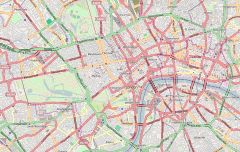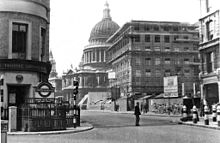- Mansion House tube station
-
Mansion House 

Entrance on Cannon Street
Location of Mansion House in Central LondonLocal authority City of London Managed by London Underground Number of platforms 3 Fare zone 1 Interchange Blackfriars NR [1]
Cannon Street NRLondon Underground annual entry and exit 2008  5.320 million[2]
5.320 million[2]2009  7.034 million[2]
7.034 million[2]2010  7.200 million[2]
7.200 million[2]1871 Opened as terminus (MDR) 1872 Started "Outer Circle" (NLR) 1872 Started "Middle Circle" (H&CR/MDR) 1884 Extended east, "Inner Circle" completed 1900 Ended "Middle Circle" 1908 Ended "Outer Circle" 1949 Started (Circle Line) 1989 Closed for rebuilding 1991 Reopened List of stations Underground · National Rail Coordinates: 51°30′44″N 0°05′39″W / 51.5122°N 0.0941°W
Mansion House is a London Underground station in the City of London, near Mansion House (although Bank station is actually closer). It is a sub-surface station served by trains on the Circle and District Lines. It is between Blackfriars and Cannon Street stations. The station is located at the junction of Queen Victoria Street and Cannon Street and is in Travelcard Zone 1. This station is within walking distance of Cannon Street tube station.
The station has three platforms. One westbound and one eastbound platform which are shared by both District and Circle lines. The third platform is for trains that arrive from the west and terminate at Mansion House station (However, the third platform is rarely used now as many services which terminate in the city now terminate at Tower Hill).
Contents
History
The station was opened on 3 July 1871 by the Metropolitan District Railway (MDR, now the District Line) when the company extended the line from Blackfriars. The station became the new eastern terminus of the MDR.
The MDR connected to the Metropolitan Railway (MR, later the Metropolitan Line) at South Kensington and, although the two companies were rivals, each company operated its trains over the other's tracks in a joint service known as the "Inner Circle".
On 1 February 1872, the MDR opened a northbound branch from its station at Earl's Court to connect to the West London Extension Joint Railway (WLEJR, now the West London Line) which it connected to at Addison Road (now Kensington (Olympia)). From that date the "Outer Circle" service began running over the MDR's tracks. The service was run by the North London Railway (NLR) from its terminus at Broad Street (now demolished) in the City of London via the North London Line to Willesden Junction, then the West London Line to Addison Road and the MDR to Mansion House.
From 1 August 1872, the "Middle Circle" service also began operations through Westminster running from Moorgate along the MR's tracks on the north side of the Inner Circle to Paddington then over the Hammersmith & City Railway (H&CR) track to Latimer Road then, via a now demolished link, to the West London Line to Addison Road and the MDR to Mansion House. The service was operated jointly by the H&CR and the MDR.
From 1 March 1883, the District operated a service between Mansion House and Windsor, using GWR tracks from a junction installed just east of Ealing Broadway, but it was unremunerative and ceased on 30 September 1885.[3][4][5]
On 10 October 1884, the MDR and the MR jointly opened the line eastwards to Mark Lane station (now closed), thereby completing the Inner Circle.
On 30 June 1900, the Middle Circle service was withdrawn between Earl's Court and Mansion House. On 31 December 1908 the Outer Circle service was also withdrawn.
In the 1920s the station entrance was rebuilt to a design by Charles Holden. It featured a tall glazed screen with Underground roundel similar to his station designs for the extension to Morden of the City & South London Railway (now the Northern Line) opened between 1924 and 1926.
In 1949, the Metropolitan Line operated Inner Circle route was given its own identity on the tube map as the Circle Line.
On 29 October 1989 the station was closed for the construction of a new entrance and renovation. It reopened on 11 February 1991.
Deep-level station
In 1897 the MDR obtained parliamentary permission to construct a deep-level tube railway running between Gloucester Road and Mansion House beneath the sub-surface line. The new line was to be an express route using electric trains to relieve congestion on the sub-surface tracks. Mansion House was to be the terminus of the express route with platforms 71 feet (22 m) below the sub-surface platforms.[6] No immediate work was carried out on the deep-level line, and the subsequent take over of the MDR by the Underground Electric Railways Company of London (UERL) and the resignalling and electrification of the MDR's routes between 1903 and 1905 meant that congestion was relieved without needing to construct the deep-level line. The plan was dropped in 1908.[7]
Transport links
London bus routes 11, 15, 17, 23, 26, 76, 100, 100, 172, 388, 521 and night routes N11, N15, N21, N26, N47, N76, N550 and N551.
References
- ^ "Out of Station Interchanges" (Microsoft Excel). Transport for London. May 2011. http://www.whatdotheyknow.com/request/67647/response/172834/attach/3/OSI%20Report%20May2011FR%20V2%2017012011.xls. Retrieved 7 August 2011.
- ^ a b c "Customer metrics: entries and exits". London Underground performance update. Transport for London. 2003-2010. http://www.tfl.gov.uk/tfl/corporate/modesoftransport/tube/performance/default.asp?onload=entryexit. Retrieved 8 May 2011.
- ^ Demuth, Tim (2004). "1881-1890". The Spread of London's Underground (2nd ed.). Harrow: Capital Transport. pp. 8–9. ISBN 1 85414 277 1.
- ^ Connor, Piers (1993). "The District Looks West". Going Green: The Story of the District Line. Harrow Weald: Capital Transport. pp. 14, 16. ISBN 1 85414 157 0.
- ^ Day, John R. (1963). "The Metropolitan District and the Inner Circle". The Story of London's Underground (1st ed.). Westminster: London Transport. pp. 24–25.
- ^ Badsey-Ellis, Antony (2005). London's Lost Tube Schemes. Capital Transport. pp. 70–71. ISBN 1-85414-293-3.
- ^ Badsey-Ellis, Antony (2005). London's Lost Tube Schemes. Capital Transport. p. 220. ISBN 1-85414-293-3.
External links
Preceding station  London Underground
London UndergroundFollowing station towards Edgware Road (via Victoria)Circle line towards Hammersmith (via Tower Hill)District line towards UpminsterClosed until 2011 Preceding station  London Underground
London UndergroundFollowing station towards Edgware Road (via Victoria)Circle line towards Hammersmith (via Tower Hill)District line towards UpminsterCircle line Stations Aldgate · Baker Street · Barbican · Bayswater ·Blackfriars · Cannon Street
· Cannon Street  · Edgware Road · Embankment · Euston Square · Farringdon
· Edgware Road · Embankment · Euston Square · Farringdon  · Goldhawk Road · Gloucester Road · Great Portland Street · Hammersmith · High Street Kensington · King's Cross St. Pancras
· Goldhawk Road · Gloucester Road · Great Portland Street · Hammersmith · High Street Kensington · King's Cross St. Pancras  · Ladbroke Grove · Latimer Road · Liverpool Street
· Ladbroke Grove · Latimer Road · Liverpool Street  · Mansion House · Monument (
· Mansion House · Monument ( Bank) · Moorgate
Bank) · Moorgate  · Notting Hill Gate · Paddington
· Notting Hill Gate · Paddington  · Royal Oak · Shepherd's Bush Market · Sloane Square · South Kensington · St. James's Park · Temple · Tower Hill (
· Royal Oak · Shepherd's Bush Market · Sloane Square · South Kensington · St. James's Park · Temple · Tower Hill ( Tower Gateway) · Victoria
Tower Gateway) · Victoria  · Westbourne Park · Westminster · Wood Lane
· Westbourne Park · Westminster · Wood Lane

Click to enlargeRolling stock History Former companiesAssociated circle linesFuture proposals Future rolling stockSee also London Underground · Transport for London
Categories:- Rail transport stations in London fare zone 1
- Circle Line stations
- District Line stations
- Tube stations in the City of London
- Former Metropolitan District Railway stations
- Railway stations opened in 1871
Wikimedia Foundation. 2010.




